#Moroccan recipe
Text
#msemmen#moroccan flatbread#moroccan food#Moroccan recipe#flatbread#tiktok#tiktok food#brattylikestoeat#food#foodlr#food blog#video#foodie#cooking stim#stim cooking#savory stim#yummy
329 notes
·
View notes
Text
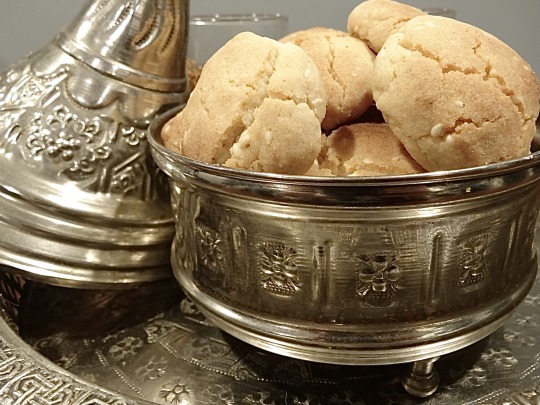
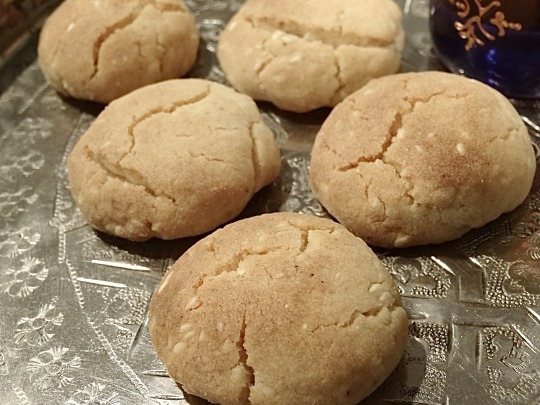
[ID: First image shows small cookies with cracked surfaces in a silver tin with pointed lid embossed with geometric designs; second image shows the same cookies on an engraved silver tray with a tea glass in the background. End ID]
غُريبة لبهلة / Ghriba l'behla (Moroccan shortbread cookies)
Ghriba l'behla (literally, "strange silly"), a popular teatime cookie, are perhaps so named because of the distinctive cracks that form on the surface of the cookies as they rise. Cookies without these distinctive cracks may be ghriba, but they are not ghriba l'behla. The melt-in-your-mouth, crumbly texture of ghriba is traditionally achieved with a 4 : 1 : 1 ratio of flour : sugar : oil.
Ghriba l'behla are commonly made with a specialized mold that gives them a concave bottom, thins them out around the edges, and causes them to crack more dramatically—the underside of a Dutch pancake pan or a mini idli tray would work for this purpose, but ghriba may also be made with a flat cookie sheet.
Though they may be made plain, ghriba are often flavored with toasted sesame, cinnamon, almonds, orange blossom water, and even lemon or orange zest. This recipe is for sesame-cinnamon ghriba, but you may also press an almond into the center of each cookie, coat them in powdered sugar, or add a couple teaspoons of orange blossom water or brine from a jar of Moroccan preserved lemons.
Recipe under the cut!
Patreon | Tip jar
Ingredients:
About 3 cups (360 - 390g) all-purpose flour
1/2 tsp fresh yeast (optional)
1/2 cup (70g) hulled sesame seeds, divided
1/2 cup (118mL) vegetable oil
1/2 cup vegan margarine or shortening, melted
3/4 cup (150 grams) vegetarian granulated sugar
Pinch of salt
1/4 tsp ground cinnamon
2 tsp baking powder
Instructions:
1. In a dry skillet over medium heat, toast sesame seeds until they are fragrant and a shade darker. Coarsely grind about half of the toasted sesame seeds in a mortar and pestle or spice mill. Set aside.
2. Melt margarine or shortening in a microwave or on the stovetop. Add sugar and stir to dissolve.
3. Combine margarine mixture and all other ingredients except for four in a large mixing bowl. Add flour a little at a time to make a dry, crumbly mixture that doesn't quite hold together when pressed; you may need more than 3 cups.
4. Knead the dough by hand, or use a stand mixer with the paddle attachment on its lowest setting, for 20 minutes. The dough should appear crumbly, like damp sand, but should now pack into a ball easily when pressed. Add more flour or oil if necessary to achieve this texture, kneading for another few minutes to incorporate.
5. Preheat your oven to 320 °F (160 °C) with the rack in its lowest position. Form the ghriba dough into balls about 3/4” (2cm) in width, packing them together with both hands and then flattening them silghtly between your palms. The edges of the dough should not crack or separate.
If you have a ghriba mold, gently press each ball of dough down over a bump on the mold, pressing down and thinning out the edges slightly to ensure a dramatic, concave bottom.
If you don't have a ghriba mold, place the ghriba on a baking sheet prepared with parchment paper. Make sure to separate them by about an inch, because they will rise slightly.
6. Turn on the broiler and broil the ghriba in the lower rack of your oven for 2-5 minutes, until cracks begin to appear on the surface.
7. Turn the broiler off and move the ghriba to the upper third of the oven. Continue to bake at 320 °F for 3-5 minutes, until very lightly golden brown and not quite firm to the touch.
8. Allow the ghriba to cool for 2 minutes, then transfer them to a wire cooling rack and allow to cool completely. Store in an airtight container.
260 notes
·
View notes
Photo
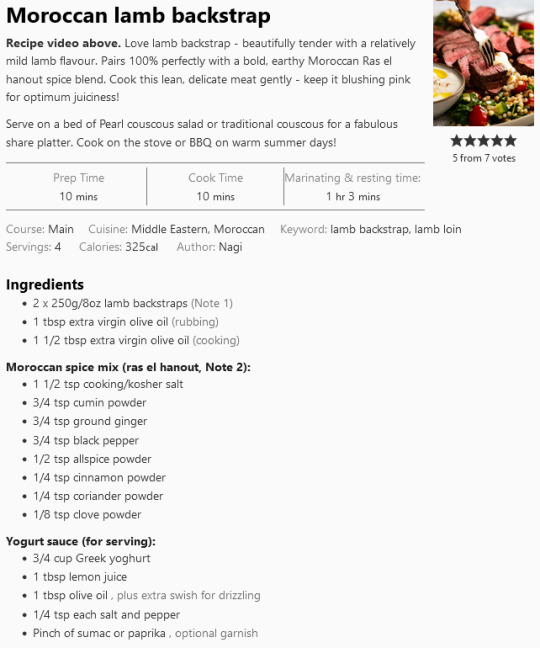
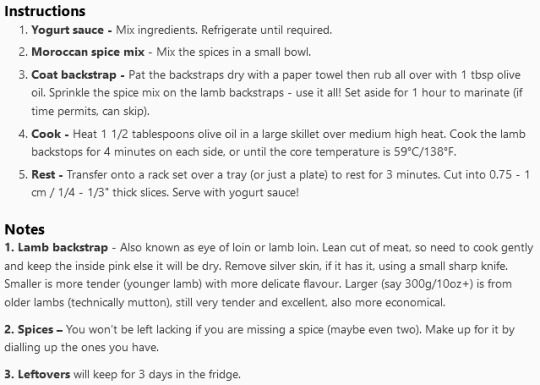
#moroccan#lamb#lamb recipes#backstrap#lamb backstrap#ras el hanout#moroccan recipe#moroccan recipes#lamb recipe#yogurt sauce#yoghurt sauce
2 notes
·
View notes
Text
Matbucha
Matbucha is a popular Moroccan and Israeli dish that is made by cooking a mixture of roasted bell peppers, tomatoes, garlic, and spices until it becomes a thick and chunky dip. It is often served as an appetizer or a side dish, and can be eaten hot or cold. The dish has a rich and complex flavor that comes from the combination of the roasted vegetables, garlic, and spices, and is often enjoyed as…

View On WordPress
#african dish#african recipe#dip#dip ideas#healthy recipe#matbucha#moroccan recipe#roasted vegetables
1 note
·
View note
Text
Moroccan Cuisine: A Blend of Flavors and Culture
Moroccan cuisine is a flavorful blend of spices, fresh ingredients, and cultural influences. Its unique features, such as the use of spices and preserved lemons, make it a true feast for the senses.
Popular dishes include tagine, couscous, harira, pastilla, and Moroccan mint tea. If you're planning a trip to Morocco, exploring its cuisine should be on your list. Many Morocco tours offer opportunities to try traditional dishes and learn about the country's food culture.
Moroccan cuisine is heavily influenced by the country's history and geography. Located in North Africa, Morocco has been a hub of trade and cultural exchange for centuries, and its cuisine reflects this diversity. The country's cuisine has been shaped by the Berbers, Arabs, Andalusians, and French, among others.
One of the hallmarks of Moroccan cuisine is its use of spices. The most common spices used in Moroccan cooking include cumin, cinnamon, paprika, turmeric, and saffron. These spices are used to flavor everything from meat and fish to vegetables and couscous.
Another distinctive feature of Moroccan cuisine is the use of preserved lemons, which are lemons that have been pickled in salt and lemon juice. Preserved lemons are a staple ingredient in many Moroccan dishes, adding a bright, tangy flavor to stews and tagines.
1 note
·
View note
Text
Virtual Recipe Box: Tabbouleh
Sometimes, I use the blog as a readily searchable recipe card catalog.
Which is why you’ll get posts like this, where I note down what I had scribbled in my kitchen lab notebook. Why don’t I just use the notebook? Well, firstly I’ve lost said notebook(s) over the years. Second, you can’t spill on the internet and make it illegible. Thirdly, I’m lazy and the phone is right here in my hand, and…
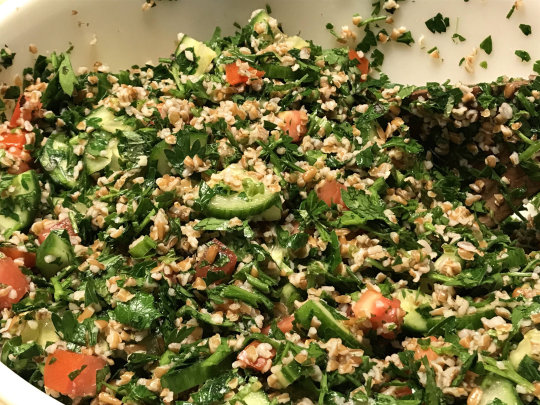
View On WordPress
0 notes
Text

Sunday lunch, or - since what with one thing and another we ate closer to dinnertime, it might be more of a Sunday dinch. :->

It was Moroccan-style braised lamb shanks, and it was really good; after 24 hours or marination and about three hours of slow cooking, the lamb was literally off-the-bone edge-of-the-fork tender.

Because the spicing was so complex (though NB like most North African dishes, not hot) we went for a simple accompaniment, plain couscous with a few strips of home-made preserved lemon to balance the deep, rich flavours.
I also included a dab of harissa with mine, and a couple of pickled chillis for zing.
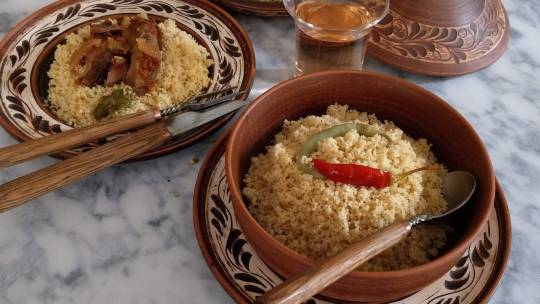
Meat and recipe both came from Irish on-line source James Whelan.
I think this would work well in a slow-cooker.
BTW, on-line recipes like this can change with the seasons, so I'm adding it below the cut.
*****
For a more fragrant and pungent dish, the lamb can be covered in clingfilm and marinated in the fridge for up to 24 hours to allow the spices to penetrate the meat. The accompanying couscous can be jazzed up with pistachio nuts and dried fruits.
Moroccan Style Braised Lamb Shanks – Printer Friendly Download
Ingredients
4 lamb shanks, well trimmed
1 tablesp. paprika
1 teasp. each ground coriander, cumin, cinnamon and turmeric
Sea salt and cracked black pepper
2 tablesp. olive oil
1 large onion, roughly chopped
2 garlic cloves, chopped
2½ cm piece peeled fresh root ginger, chopped
450ml chicken or lamb stock
2 x 400g cans chopped tomatoes
1 tablesp. clear honey
Squeeze of lemon juice
Serve with a bowl of couscous
Serves: 4
To Cook
Cooking Time: 2¾ hours
Preheat the oven to Gas Mark 3, 160ºC (325ºF).
Heat a large frying pan.
Mix together the paprika, coriander, cumin, cinnamon, turmeric and one teaspoon of pepper in a large bowl.
Add the lamb shanks and using your hands rub in the spices.
Add a little of the olive oil to the heated pan and quickly brown off two of the spiced lamb shanks.
Transfer to a casserole dish with a lid and repeat with the remaining lamb shanks.
Meanwhile, place the onion, garlic and ginger in a food processor or mini-blender and pulse until finely minced.
Add another tablespoon of the olive oil to the pan, then add the onion mixture and sauté for 3-4 minutes until well softened and coloured from the spices left in the bottom of the frying pan.
Pour a little of the stock into the pan, stirring to combine and then tip over the lamb shanks.
Add the remaining stock with the tomatoes and honey, stirring gently until evenly combined.
Cover with the lid and cook for 2-2½ hours until the lamb shanks are meltingly tender and the meat is ready to fall off the bone.
Add a squeeze of lemon juice and season to taste.
We hope you enjoyed reading this post by Pat Whelan of James Whelan Butchers. Pat is a 5th generation butcher, cook book author and the director of James Whelan Butchers with shops in Clonmel, the Avoca Handweavers Rathcoole and Kilmacanogue, Dunnes Stores Cornelscourt, Rathmines and Swords in Dublin.
382 notes
·
View notes
Text

Moroccan Baked Feta with Olive Tapenade
#food#recipe#appetizer#baked feta#tapenade#olives#peppers#walnut#harissa#garlic#tomatoes#cheese#parsley#feta#baking#gluten free#moroccan#vegetarian
188 notes
·
View notes
Text

Vegan Tagine With Chickpeas
#moroccan#winter#stew#lunch#dinner#savoury#chickpeas#tagine#chickpea#glutenfree#gluten free#parsley#food#recipe#recipes#vegan#veganism#plantbased#plant based#vegetarian#butternut squash#pumpkin#healthy food#healthy recipes#cooking#whatveganseat#what vegans eat#healthy eating#healthy living#healthy lifestyle
55 notes
·
View notes
Text
So I was on the phone with my sisters and my father and I started getting out vegetables and meat to cook dinner and my Baba said "you're not going to make a tajine now?" (it was around 10.30pm). And I said "it's alright, it's not gonna take too long, I'm just throwing everything into the pan and letting it cook". And my Baba went full offended gasping "oh hell no, if you're going to make a tajine you're going to make it right and that takes at least 45 minutes!". So I said "uuuh, tell me again how it's made, because I think I'm missing something?..."
Turns out I've been making my tajines wrong all along, but now I know how to make them right, so I'll share with you.
Moroccan tajine (for 1 person) :
- onion and garlic to taste
- meat to taste (preferably lamb)
- 2 carrots
- 1 courgette (or half if it's a big one)
- 2 potatoes
- spices
To start:
Cut the onion in thin slices and the garlic roughly. Put them in the saucepan with a bit of water, just enough to cover them but not drown them.
Let them simmer for around 15 minutes, until the onion is melted.

In the meantime get the rest of your vegetables ready.
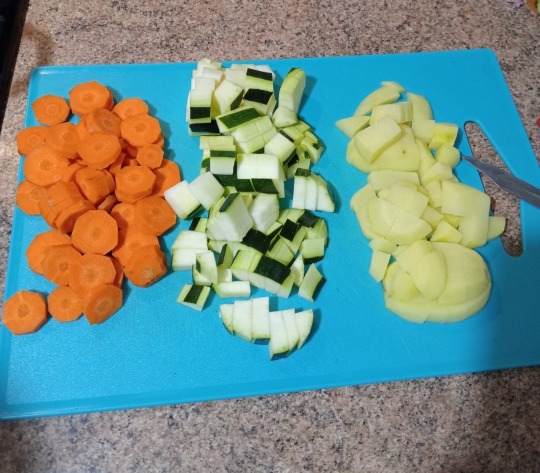
Once you deem the onion sufficiently translucid, add your meat (sorry, I don't know the timing for vegetarian equivalent meat).
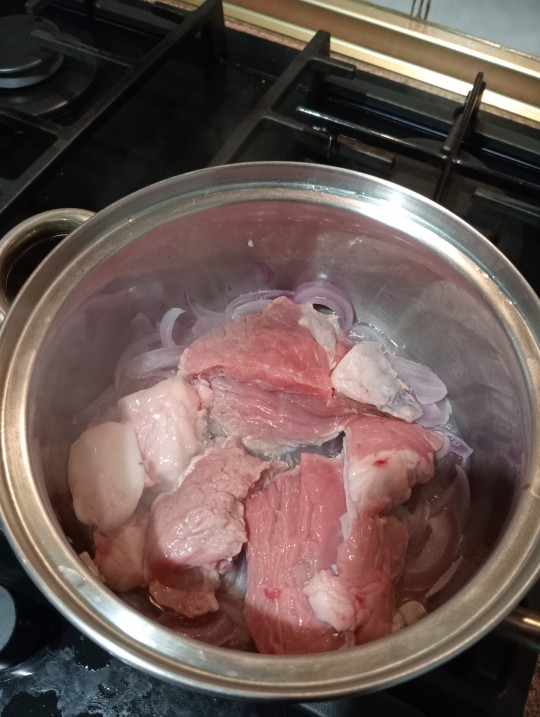
At this point, add your spices. I personally put the classics, salt, pepper and cumin (cumin is very important), and then I add paprika, ginger and rosemary.
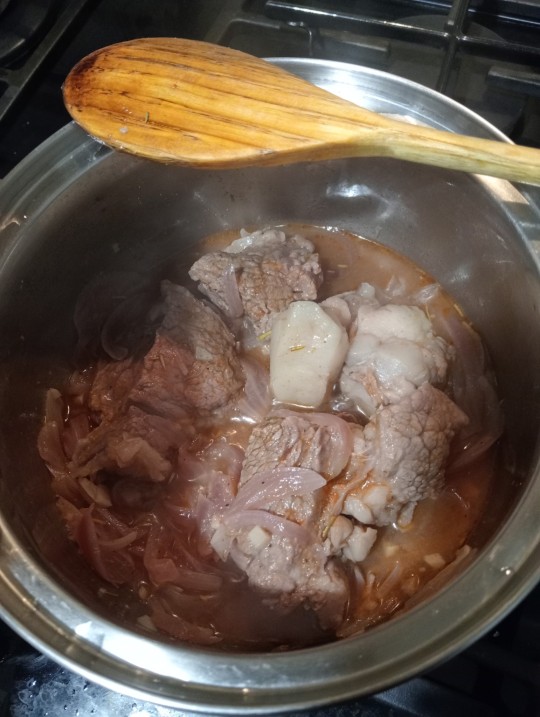
Let the meat cook for another 15 minutes or so and add the carrots. Carrots take a long time to cook so you add them before the rest.

Wait for another 20-25 minutes, cooking on slow burn and checking regularly the water. You don't want your sauce to evaporate. The water you add if necessary must be heated.
You can add the rest of your vegetables after 20 minutes, when the carrots are already starting to cook well.

And now you let it all cook gently and slowly until the vegetables are ready. Don't eat immediately, it's very hot! A traditional Moroccan tajine is usually cooked in a clay dish like this, so it's dangerously hot.

And that's it! Quite simple in the end, but it does take a hot minute.
26 notes
·
View notes
Text

[ID: Buttermilk being poured from a Moroccan ceramic cup with orange and black geometric designs into a glass. End ID]
لبن نباتي / Lbn nabati (Vegan traditional buttermilk)
Lbn (لْبْنْ or لْبَنْ; also transliterated "lban") is a Moroccan buttermilk drink. It is not to be confused with standard Arabic لَبَن ("laban"), meaning "milk"; with Levantine لَبَن ("laban"), also called لَبَن رَائِب ("laban ra'ib"), which is curdled milk (a.k.a., yoghurt); or with Levantine لَبْنَة ("labna"), which is yoghurt that has been strained and thickened.
Instead, lbn is a traditional buttermilk. It is historically made the same way Western traditional buttermilk is: by leaving raw milk to sit at room temperature while the cream separates and rises to the top, allowing the cream to ferment, and then churning the cream until it separates further into milk solids (cultured butter) and a cultured liquid byproduct (traditional buttermilk). Commercial Western buttermilk, and some Moroccan lbn, is now no longer traditional buttermilk but instead cultured buttermilk, which is produced by fermenting low-fat milk; this produces a thicker, more acidic liquid than traditional buttermilk. Lbn is usually made with goat's milk, though cow's milk is also often used.
Lbn—very sour and tangy, slightly sweet, and about the consistency of milk—is consumed as a refreshing after-dinner drink during the summer. It is also used to soak كُسْكُس ("couscous") (made from durum, barley, or corn flour). Couscous with lbn is called سَيْكُوك ("saykouk") in Darija (Moroccan Arabic), or أزَيْكُوك ("azaykouk") in Tamazight.
Saykouk is a cold dish, commonly eaten in the desert and in rural areas during the summertime; but it is also sold from food carts and by vendors on bicycles year-round in cities. On Fridays, Moroccans often eat couscous dishes with lbn on the side, and may make some on-the-fly saykouk by pouring lbn into their bowls to soak the couscous that remains after the vegetables or meat in the dish have been eaten.
This recipe resembles cultured buttermilk, in that it ferments non-dairy milk with live cultures to achieve a sour taste. However, it more resembles traditional dairy buttermilk in taste and texture. Note that this lbn is intended for drinking and for recipes that call for Moroccan traditional buttermilk, and not for replacing Western cultured buttermilk in pastries or pancakes.
Recipe under the cut!
Patreon | Paypal | Venmo
Ingredients:
2 cups full-fat oat milk
1-3 vegetarian probiotic capsules (containing at least 10 billion cultures total)
A few pinches salt
A few pinches granulated sugar
Make sure your probiotic capsules contain no prebiotics, as they can interfere with the culture. The probiotic may be multi-strain, but should contain some of: Lactobacillus casei, Lactobacillus rhamnosus, Bifidobacterium bifidus, Lactobacillus acidophilus. The number of capsules you need will depend on how many cultures each capsule is guaranteed to contain.
Instead of probiotic capsules, you can use a specialty starter culture pack intended for use in culturing vegan dairy, many of which are available online. Note that starter cultures may be packaged with small amounts of powdered milk for the bacteria to feed on, and may not be truly vegan.
Other types of non-dairy milk may work. My trial with soy milk did not succeed (it never became notably tangy). Soaked and blended cashews will thicken substantially, so be sure to blend cashews with at least twice their volume in (just-boiled, filtered) water if you want to use cashews as your base. I found that oat milk, as well as being more convenient and cheaper than cashews, more closely mimicked the taste of lbn. I have not tested anything else.
Instructions:
1. Boil several cups of water and use the just-boiled water to rinse your measuring cup, the container you will ferment your lbn in, and a wooden spoon or rubber spatula to stir. Your bowl and stirring implement should be in a non-reactive material such as wood, clay, glass, or silicone.
2. Measure oat milk into a container and open probiotic capsules into it. Stir the powder from the capsules in until well combined.
3. Cover the opening of the container with a cheesecloth or tea towel. Ferment for 24 hours: on the countertop in temperate weather, or in an oven with the light on in cold weather.
Taste the lbn with a clean implement (avoid double-dipping!) to see if it is ready. If it still tastes 'oaty,' continue fermenting for another 1-3 days, tasting every 12 hours, until it is notably tangy.
4. Blend lbn with large pinches of salt and sugar; or put lbn, salt, and sugar in a jar with a lid and shake to combine. Taste and adjust salt and sugar.
5. Store in an airtight container in the refrigerator for up to a week. This lbn will continue to culture slowly in the fridge and will eventually (like dairy lbn) become too sour to drink.
Serve chilled.
#I'm really excited about this one guys I have been racking my brain for a way to make vegan lbn forever!!#but that was before I knew about the power of culturing#Moroccan#cultured#fermented#vegan recipes#vegetarian recipes
77 notes
·
View notes
Photo

Moroccan Meat Cigars
Spiced ground beef is rolled up in phyllo sheets and baked to make these savory Moroccan pastries. Serve with hummus on the side for a great party appetizer!
2 notes
·
View notes
Photo
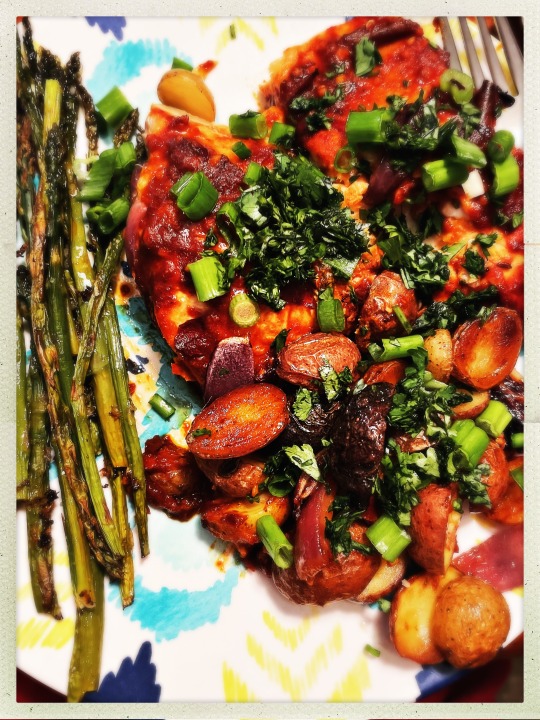
I got a craving for salmon today, so I looked up recipes, and found this one, for Sheet-Pan Harissa Salmon with Potatoes and Citrus. I love Moroccan-inspired flavors, and am pretty well-versed in cooking with them, so I decided to go with it. I ended up having to make my own harissa paste, because the store didn’t have it—but it was fine; we had all the ingredients at home already, and it ended up tasting better than any pre-packaged harissa I’ve ever had. I served it with a side of oven-roasted asparagus with lemon juice and zest, and as there’s orange juice and zest in the salmon marinade, it was the perfect tie-in.
#food#home cooking#salmon#harissa#moroccan inspired#my photos#dm me if you need a screenshot of the salmon recipe#it’s from nyt cooking and i got a one year subscription for xmas so i am very willing toshare
7 notes
·
View notes
Text
Shrimp Tagine Combines fresh tomatoes, plentiful garlic, green herbs, spicy saffron and shrimp with Harissa and Preserved Lemon Puree.
This recipe was distributed by Mourad Lahlou thanks to a Moroccan cookbook translated in the 70s !


#moroccan cuisine#moroccan food#moroccan gastronomy#morocco#history of morocco#moorish#moors#moroccan#moroccan culture#moroccan history#cuisine marocaine#gastronomie marocaine#food#foodstagram#food diary#food log#anime food#foodporn#recipe#cooking#drinks#baking#fruit#moroccan recipe#desserts#cheese#shrimp#salmon#tuna#chicken
4 notes
·
View notes
Text
Hi, I want to cook more this summer because it genuinely is good for my mental health, so if any mutuals want to drop some recipes in my ask box uh.... 👀👀👀
#personal#ESPECIALLY non American recipes#i can make my homemade mac and cheese and garlic parm noodles from memory I'm desperate for something else#some new faves ive been making are chicken adobo and this Moroccan lentil soup which have both been nice to add to the rotation#i also make chicken korma but i cheat BIG TIME with jarred sauce that i then add stuff to#im hoping to get practice making that from scratch this summer#i will gladly trade recipes if you want#i also make a really easy tomato tortellini soup that always crowd pleases#or some awesome pumpkin cupcakes
2 notes
·
View notes
Text
Mechoui (morocco)
Moroccan mechoui is a popular grilled lamb dish in Moroccan cuisine. The lamb is traditionally slow-cooked over charcoal or wood fire, resulting in a tender and flavorful meat with a smoky taste. The meat is usually seasoned with a blend of Moroccan spices such as cumin, coriander, paprika, and garlic, and served with a side of bread, harissa sauce, and preserved lemons. Mechoui is often enjoyed…

View On WordPress
2 notes
·
View notes